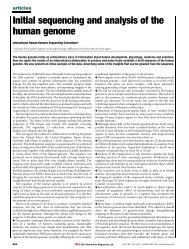Investigating a Hungarian Language Learning Aptitude Test with ...
Investigating a Hungarian Language Learning Aptitude Test with ...
Investigating a Hungarian Language Learning Aptitude Test with ...
You also want an ePaper? Increase the reach of your titles
YUMPU automatically turns print PDFs into web optimized ePapers that Google loves.
Extract 4It is not convenient if I am saying what I am thinking. My time is runningout if I am thinking aloud.In all the items András had time to attend to he translated the sentences by extrapolatingthe necessary linguistic patterns and forms from the sample sentencesand words, and sometimes from the previous items:Extract 5The dog chased the cat. (item 2) Which is the expression of kau meud biwhere kau is the dog, and here we are not talking about chasing butwatching, which is so, so that’s why I think the answer to question two iskau meud so.In Extract 5, as this was in the beginning and he was still not comfortable <strong>with</strong>thinking aloud, András had already found the response by the time I asked him toreport on his thoughts. In items 2 and 3 he ignored the fact that the sentences werein the past tense. In item 4 he realised that the only difference between this and theprevious sentence was the tense. Although he extrapolated how to form the pasttense successfully, and realized that he had done something incorrectly in the previousitems, he did not go back and correct his former responses accordingly, buthe said: “I might have screwed the whole thing?” However, subsequently he managedto indicate the past and the present tense appropriately.One of the grammar rules of this artificial language the test-takers are supposedto extrapolate from the sample sentences is that when both the subject andthe object, which stand directly next to each other in sentences, are pronouns, theseparate words merge into one word, and the last letter of the objective pronoun isomitted. When András first came across this unique grammatical structure in item5 he sounded surprised: “Oh, my god.” Nevertheless, he managed to find the correctanswer because after applying the linguistic patterns and formulas he hadpreviously deduced, only one possible answer was left, but he was still not sure ofhimself:Extract 6I am checking the expressions on the above list. (8 sec) You is xa, us is pa,watch is so (.) Xa (.) Pa (.) Xa (.) Xa (.) Pso. I think so. I don’t know. (...)No. It just doesn’t add up. But I have no other idea.Subsequently, when this formula was necessary to call for (items 7, 8 and 9), heused it appropriately <strong>with</strong>out hesitation, even when a distracter was similar to thecorrect one, but ignored the rule of the omission of the objective pronouns’ lastletter (item 11) among the four alternatives. In item 10 a new grammatical structure,the negative appeared. At first he was taken aback (“By golly!”), but afterstudying the sample sentences for a while he could extrapolate and apply the rulein this and the following sentences. Within the allocated 15 minutes András couldattend to twelve out of 20 items, out of which he managed to solve 10 correctly.262 UPRT 2007: Empirical studies in English applied linguistics
















